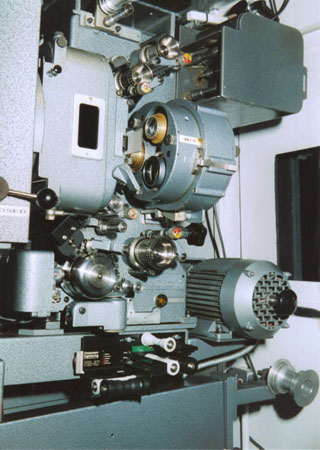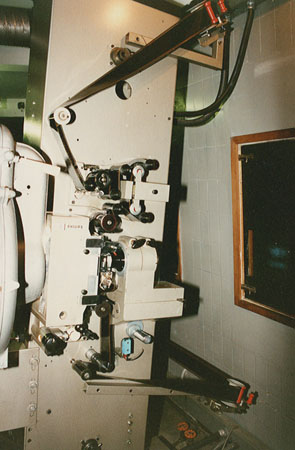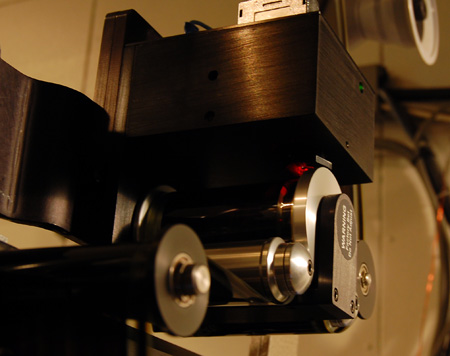Exhibitor's Toolkit: Re-awakening "dormant" 35/70mm machines |
Read more
at in70mm.com The 70mm Newsletter |
| Written by: Ramon Lamarca Marques, Brian Guckian and Mike Taylor | Date: 09.05.2008 |
|
This article provides a guide to Exhibitors who wish to
re-activate 70mm capability in their venues, using existing
35/70mm equipment currently configured for 35mm-only. |
More
in 70mm reading: 65/70mm Workshop Internet link: |
Background |
|
 Cinemeccanica Victoria 8 projector set up for 70mm. Note the
magnetic head cluster fitted to the projector (top right)
for reading 70mm magnetic soundtracks. A DTS-70 timecode
reader should also be fitted to reproduce contemporary 70mm
soundtracks (not shown).
Courtesy Mike Taylor Cinemeccanica Victoria 8 projector set up for 70mm. Note the
magnetic head cluster fitted to the projector (top right)
for reading 70mm magnetic soundtracks. A DTS-70 timecode
reader should also be fitted to reproduce contemporary 70mm
soundtracks (not shown).
Courtesy Mike TaylorThe work begins with an assessment by the resident service engineer of the existing equipment. Restoration of 70mm capability where a dual-gauge machine is in situ typically involves the following: - Full mechanical service; - Restoration of 70mm gate, incl. aperture and pressure plates as applicable, using new parts if necessary; - New or restored beam spreader for 70mm; - Restoration of 70mm lens; - Replacement of worn sprockets; - Restoration of magnetic sound penthouse for playback of classic 70mm titles; - Fitting of DTS reader; if DTS sound is already fitted for 35mm then replacement of the existing 35mm-only reader with a dual 35/70mm reader should be actively considered; - Acquisition of DTS sound playback system if not already installed; - Modification to sound rack wiring and amplification to allow for 5 stage channels and preferably three surround channels; with existing sub-woofer this facilitates future playback of 9-channel material from 35mm and digital video as well as 70mm, and also allows playback of classic 70mm titles mixed for 5 stage channels; - Installation of additional loudspeakers as required |
|
Funding - the "Premiere Screen" concept |
|
 Philips / Kinoton DP75 with 70mm film threaded. The magnetic
head cluster can be seen located above the lens mount. Again
a DTS-70 timecode reader is essential for contemporary 70mm
sound reproduction (not shown). Philips / Kinoton DP75 with 70mm film threaded. The magnetic
head cluster can be seen located above the lens mount. Again
a DTS-70 timecode reader is essential for contemporary 70mm
sound reproduction (not shown).Courtesy Ben Wales An upgrade to the largest screen in a cinema complex - which usually can include a "dormant" 35/70mm machine if the complex was constructed in the 1990s - could be carried out as a "Premiere Screen" project. The re-vamp of the projection and sound system could be paid for by a small premium on ticket prices. Decor and ambience could also be upgraded, and if the screen has not previously been THX-certified, consideration could be given to this work, which, by providing significant further upgrades to the sound system via a loudspeaker baffle wall and greatly enhanced acoustics, would support the technical presentation even more. The interested Exhibitor could go further by installing a curved screen to a modern immersive design. Of great advantage is that the "Premiere Screen" concept typically involves just one screen (or for large complexes, two), thus minimising outlay and maximising returns. In large complexes the second screen capability is advantageous in transferring 70mm titles after the initial period of the run. |
|
Embedding Training and Standards as part of the Package |
|
 DTS
reader for 70mm. In this case reading the DTS time code from a "Titanic"
70mm print 29.04.2008. Image by Thomas Hauerslev DTS
reader for 70mm. In this case reading the DTS time code from a "Titanic"
70mm print 29.04.2008. Image by Thomas Hauerslev Training for the projection and handling of 70mm, as well as high standards for same, is absolutely essential, and should be made a condition of receiving 70mm product by the studios. Training would cover issues in handling classic prints as well as new titles in 70mm, and standards could be maintained via an Accreditation Programme*. [* It is hoped to add more on this concept at a later date] |
|
Limited Exhibition (by Mike Taylor) |
|
|
The 65/70mm Workshop team have continued to look at the theme of "Waking
the Sleeping Giant", by researching the state of the current exhibition
facilities for the screening of 70mm motion pictures. Whilst it would be very nice to see the return of 70mm in our theatres all around the world, we have to be realistic and practical to accept that this could only be achieved on a limited basis. The commitment from Producers, Distributors and Exhibitors would dictate any progress made in this direction. A small worldwide circuit of motion picture theatres for 70mm could very well service a travelling programme of reprinted archive material and new product as envisaged through the 65/70mm Workshop. The response from the movie-going public to these venues if linked to high-profile publicity could produce some interesting statistics, and who knows, might very well encourage other outlets to screen 70mm motion pictures and ensure the Sleeping Giant sleeps no longer. |
|
|
Go: back
- top - back issues
- news index Updated 22-01-25 |
|
